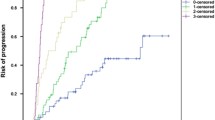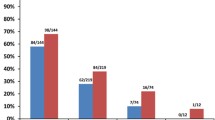Abstract
Patients always have different responses to the same treatment due to the heterogeneity of multiple myeloma (MM). However, the relationship between monoclonal protein (M-protein) reduction rates during treatment and survival prognosis in MM patients remains controversial. We retrospectively analyzed 198 newly diagnosed MM patients who received regular bortezomib-based chemotherapy for at least 2 cycles and subsequent autologous stem cell transplantation (ASCT) plus continuous maintenance. The relationship between the early M-protein reduction rates and survival prognosis was evaluated. This study is the first to divide patients into three patterns, namely, A, B, and C, according to the M-protein reduction rate during the first two therapy cycles. The results showed that pattern B patients with progressive reduction in M-protein had better progression-free survival (PFS) and overall survival (OS) than did pattern A or C patients with precipitating or slow M-protein reduction (75.33 ± 18.81 versus 41.23 ± 9.13 or 26.60 ± 6.67 months; P < 0.001; 117.33 ± 18.44 versus 71.00 ± 10.06 or 39.73 ± 24.10 months; P = 0.003, respectively). In addition, biological analysis showed that pattern A + C patients had higher international staging system (ISS) stage III proportions (P = 0.008) and lactate dehydrogenase (LDH) elevations (P = 0.044) than pattern B patients. Furthermore, pattern A + C was a significant independent adverse parameter for PFS and OS (HR = 2.62, P = 0.001; HR = 2.15, P = 0.022, respectively). Thus, our results demonstrate that pattern A + C indicates an inferior survival prognosis in MM.


Similar content being viewed by others
Abbreviations
- ASCT:
-
autologous stem cell transplantation
- FISH:
-
fluorescence in situ hybridization
- ISS:
-
international staging system
- IFN-a:
-
interferon-a
- LDH:
-
lactate dehydrogenase
- M-protein:
-
monoclonal protein
- MM:
-
multiple myeloma
- OS:
-
overall survival
- PAD:
-
bortezomib, pegylated liposomal doxorubicin, dexamethasone
- PFS:
-
progression-free survival
- PR:
-
partial response
- SFLC:
-
serum-free light chain
- VD:
-
bortezomib, dexamethasone
- VGPR:
-
very good partial remission
References
Rasche L, Kortum KM, Raab MS et al (2019) The impact of tumor heterogeneity on diagnostics and novel therapeutic strategies in multiple myeloma. Int J Mol Sci 20(5)
Bolli N, Avet-Loiseau H, Wedge DC et al (2014) Heterogeneity of genomic evolution and mutational profiles in multiple myeloma. Nat Commun 5:2997
Kumar S, Paiva B, Anderson KC, Durie B, Landgren O, Moreau P, Munshi N, Lonial S, Bladé J, Mateos MV, Dimopoulos M, Kastritis E, Boccadoro M, Orlowski R, Goldschmidt H, Spencer A, Hou J, Chng WJ, Usmani SZ, Zamagni E, Shimizu K, Jagannath S, Johnsen HE, Terpos E, Reiman A, Kyle RA, Sonneveld P, Richardson PG, McCarthy P, Ludwig H, Chen W, Cavo M, Harousseau JL, Lentzsch S, Hillengass J, Palumbo A, Orfao A, Rajkumar SV, Miguel JS, Avet-Loiseau H (2016) International Myeloma Working Group consensus criteria for response and minimal residual disease assessment in multiple myeloma. Lancet Oncol 17(8):e328–e346
Perrot A, Lauwers-Cances V, Corre J et al (2018) Minimal residual disease negativity using deep sequencing is a major prognostic factor in multiple myeloma. Blood 132(23):2456–2464
Landgren O, Lu SX, Hultcrantz M (2018) MRD testing in multiple myeloma: the main future driver for modern tailored treatment. Semin Hematol 55(1):44–50
Lahuerta JJ, Paiva B, Vidriales MB et al (2017) Depth of response in multiple myeloma: a pooled analysis of three PETHEMA/GEM clinical trials. J Clin Oncol 35(25):2900–2910
Gay F, Larocca A, Wijermans P et al (2011) Complete response correlates with long-term progression-free and overall survival in elderly myeloma treated with novel agents: analysis of 1175 patients. Blood 117(11):3025–3031
Schaar CG, Kluin-Nelemans JC, le Cessie S, Franck PF, te Marvelde MC, Wijermans PW (2004) Early response to therapy and survival in multiple myeloma. Br J Haematol 125(2):162–166
van Rhee F, Bolejack V, Hollmig K et al (2007) High serum-free light chain levels and their rapid reduction in response to therapy define an aggressive multiple myeloma subtype with poor prognosis. Blood 110(3):827–832
Prica A, Trieu Y, Xu W et al (2013) Rapidity and quality of response to steroid-based induction therapy, without the addition of novel agents, does not affect post transplant outcomes in multiple myeloma. Clin Lymphoma Myeloma Leuk 13(1):25–31
Tandon N, Sidana S, Rajkumar SV et al (2019) Outcomes with early response to first-line treatment in patients with newly diagnosed multiple myeloma. Blood Adv 3(5):744–750
Mateos MV, San MJ (2017) Management of multiple myeloma in the newly diagnosed patient. Hematology Am Soc Hematol Educ Program 1:498–507
Attal M, Lauwers-Cances V, Hulin C et al (2017) Lenalidomide, bortezomib, and dexamethasone with transplantation for myeloma. N Engl J Med 376(14):1311–1320
Durie BG, Hoering A, Abidi MH et al (2017) Bortezomib with lenalidomide and dexamethasone versus lenalidomide and dexamethasone alone in patients with newly diagnosed myeloma without intent for immediate autologous stem-cell transplant (SWOG S0777): a randomised, open-label, phase 3 trial. Lancet 389(10068):519–527
Mohan M, Matin A, Davies FE (2017) Update on the optimal use of bortezomib in the treatment of multiple myeloma. Cancer Manag Res 9:51–63
Cengiz SG, Beksac M (2018) The safety of bortezomib for the treatment of multiple myeloma. Expert Opin Drug Saf 17(9):953–962
Narita T, Inagaki A, Kobayashi T et al (2015) t(14;16)-positive multiple myeloma shows negativity for CD56 expression and unfavorable outcome even in the era of novel drugs. Blood Cancer J 5:e285
Gutierrez NC, Castellanos MV, Martin ML et al (2007) Prognostic and biological implications of genetic abnormalities in multiple myeloma undergoing autologous stem cell transplantation: t(4;14) is the most relevant adverse prognostic factor, whereas RB deletion as a unique abnormality is not associated with adverse prognosis. Leukemia 21(1):143–150
Gertz MA, Lacy MQ, Dispenzieri A et al (2005) Clinical implications of t(11;14)(q13;q32), t(4;14)(p16.3;q32), and -17p13 in myeloma patients treated with high-dose therapy. Blood 106(8):2837–2840
Kumar SP, Paiva BP, Anderson KCP et al (2016) International Myeloma Working Group consensus criteria for response and minimal residual disease assessment in multiple myeloma. Lancet Oncology 17(8):e328–e346
Goldschmidt H, Lokhorst HM, Mai EK et al (2018) Bortezomib before and after high-dose therapy in myeloma: long-term results from the phase III HOVON-65/GMMG-HD4 trial. Leukemia 32(2):383–390
Cook G, Williams C, Brown JM, Cairns DA, Cavenagh J, Snowden JA, Ashcroft AJ, Fletcher M, Parrish C, Yong K, Cavet J, Hunter H, Bird JM, Chalmers A, O'Connor S, Drayson MT, Morris TC, National Cancer Research Institute Haemato-oncology Clinical Studies Group (2014) High-dose chemotherapy plus autologous stem-cell transplantation as consolidation therapy in patients with relapsed multiple myeloma after previous autologous stem-cell transplantation (NCRI Myeloma X Relapse [Intensive trial]): a randomised, open-label, phase 3 trial. Lancet Oncol 15(8):874–885
Sonneveld P, Schmidt-Wolf IG, van der Holt B et al (2012) Bortezomib induction and maintenance treatment in patients with newly diagnosed multiple myeloma: results of the randomized phase III HOVON-65/ GMMG-HD4 trial. J Clin Oncol 30(24):2946–2955
Harousseau JL, Attal M, Avet-Loiseau H et al (2010) Bortezomib plus dexamethasone is superior to vincristine plus doxorubicin plus dexamethasone as induction treatment prior to autologous stem-cell transplantation in newly diagnosed multiple myeloma: results of the IFM 2005-01 phase III trial. J Clin Oncol 28(30):4621–4629
Yan Y, Mao X, Liu J, Fan H, du C, Li Z, Yi S, Xu Y, Lv R, Liu W, Deng S, Sui W, Wang Q, Zou D, Wang J, Cheng T, Zhan F, Tai YT, Yuan C, du X, Qiu L, Anderson KC, An G (2019) The impact of response kinetics for multiple myeloma in the era of novel agents. Blood Adv 3(19):2895–2904
Mellors PW, Binder M, Buadi FK, Lacy MQ, Gertz MA, Dispenzieri A, Hayman SR, Kapoor P, Gonsalves WI, Hwa YL, Fonder A, Hobbs M, Kourelis T, Warsame R, Zeldenrust SR, Lust JA, Leung N, Go RS, Kyle RA, Vincent Rajkumar S, Kumar SK (2018) Time to plateau as a predictor of survival in newly diagnosed multiple myeloma. Am J Hematol 93(7):889–894
Camp RL, Dolled-Filhart M, Rimm DL (2004) X-tile: a new bio-informatics tool for biomarker assessment and outcome-based cut-point optimization. Clin Cancer Res 10(21):7252–7259
Dejoie T, Corre J, Caillon H et al (2019) Responses in multiple myeloma should be assigned according to serum, not urine, free light chain measurements. Leukemia 33(2):313–318
Dejoie T, Corre J, Caillon H et al (2016) Serum free light chains, not urine specimens, should be used to evaluate response in light-chain multiple myeloma. Blood 128(25):2941–2948
Martinez-Lopez J, Paiva B, Lopez-Anglada L et al (2015) Critical analysis of the stringent complete response in multiple myeloma: contribution of sFLC and bone marrow clonality. Blood 126(7):858–862
Dispenzieri A, Kyle R, Merlini G et al (2009) International Myeloma Working Group guidelines for serum-free light chain analysis in multiple myeloma and related disorders. Leukemia 23(2):215–224
Funding
This work was supported by the Sun Yat-sen University medical clinical trial “5010 Plan” 2017005.
Author information
Authors and Affiliations
Corresponding author
Ethics declarations
Conflict of interest
The authors declare that they have no conflicts of interest.
Ethical standards statement
All procedures followed were in accordance with the ethical standards of the responsible committee on human experimentation (institutional and national) and with the Helsinki Declaration of 1975, as revised in 2008 (5).
Statement of informed consent
Informed consent was obtained from all patients for being included in the study.
Additional information
Publisher’s note
Springer Nature remains neutral with regard to jurisdictional claims in published maps and institutional affiliations.
Electronic supplementary material
ESM 1
(PDF 81 kb)
Rights and permissions
About this article
Cite this article
Xu, L., Liu, J., Chen, M. et al. Early monoclonal protein decline pattern is an independent prognostic factor in patients with multiple myeloma. Ann Hematol 99, 581–589 (2020). https://doi.org/10.1007/s00277-020-03915-9
Received:
Accepted:
Published:
Issue Date:
DOI: https://doi.org/10.1007/s00277-020-03915-9




